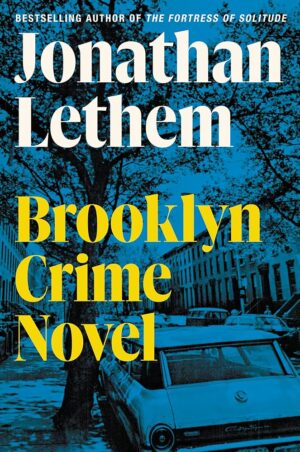Brooklyn Crime Novel
by Jonathan Lethem
reviewed by Gideon Leek
“It was time to leave Brooklyn in a literary sense anyway—between Motherless Brooklyn and Fortress of Solitude I had really plumbed childhood in Brooklyn. I really needed to defy all that stuff about place and memory.” So said Jonathan Lethem in 2007. Now, Lethem is back. He’s changed, and so has the neighborhood. But changed from what exactly? After all, Brooklyn has always been a bit phony.
“He’s amazed by the persistence of new owners who trouble to replace the shattered sidewalk slate with fresh slabs of grey stone rather than mere poured concrete” and by “Italians who will hoist a gleaming black new cornice and attach it to the roof in one afternoon,” writes Lethem of one of his characters. These refurbishments of yesteryear expanded the truly historic blocks of downtown Brooklyn—Dean, Pacific, Clinton, and Pierrepont, per Lethem—into an illusion of architectural uniformity. As Lethem puts it: “What if Brownstone Brooklyn is salted with fakes to begin with?”
Lethem is a Brooklyn fake, too. In several scenes, childhood friends tell off a big-shot novelist who has mythologized their youth: “You’re our tuning fork. Our percussive resonator. The book is so very full of … music. It’s like a great pop song,” says one such character. According to another: “You gentrified gentrification.” Meekly, the author figure protests: “Go write your own version if you think I got it wrong.” Now, in Lethem’s latest, he wants to get it right.
Instead of an autobiography juxtaposing his own coming of age with the changing neighborhood, like The Fortress of Solitude, or a novel about getting told off for getting things wrong like Phillip Roth in Zuckerman Unbound, Brooklyn Crime Novel is a mix of fictional vignettes and historical facts about the borough from the 70s onward. Some motifs are woven throughout the book, but there is no central plot or central character. Lethem wants to de-emphasize his own “stuff about place and memory.” He already wrote that book. There are “no painterly effects,” and the characters “don’t need names.” This time there’s “no need to pin butterflies.” The lack of names is strategic. After all, how could he ever top Dylan Ebdus and Mingus Rude? But the butterflies bit, an allusion to the popular image of serial killers from John Fowles’s The Collector to the famous poster for The Silence of the Lambs, is telling. Lethem doesn’t want to sensationalize or glamorize the past anymore. This is a book which strives not to be personal, not to be beautiful, and not to create a grand narrative. It succeeds on its own inherently undramatic terms, but there is something sterile and academic about the whole premise. Either way, there is much to enjoy: Brooklyn Crime Novel is dense, layered, highly referential, well-researched, and often very funny.
In a 2007 interview with The Paris Review, Lethem noted that “The first third of my life was spent at political demonstrations, shouting my lungs hoarse,” but it was also a time when, as one of the few white students at his public school, he “endur[ed] beatings and bullyings, as well as subtler psychic torments.” The very people he was devoting his weekends to protecting were taking his lunch money. If gentrification is the novel’s “Brooklyn Crime,” then mugging is vigilante justice.
Describing the common practice of white Brooklyn parents giving their children mugging money, Lethem wonders, “The arrangement made—how? Did the parents consult? Or arrive at this each independently.” Reluctant to involve authorities or promote violence, the parents of his youth urged compliance, hoping to reframe the experience as an everyday annoyance. This protected the kids to a degree. Lethem tells of his friend “Muggable Theo” (“He practically mugs himself”) and describes various funny muggings: “The Pizza Mugging,” “The Check Mugging,” and “The Guilt-Tripped Stickup.” But there is a threat of escalation lurking behind any robbery. When, in one of the book’s vignettes, one of the many tacitly consented-to muggings results in a life-changing act of violence, it’s hard not to blame the misguided parents for the whole thing.
The karmic interplay between the first generation of social justice warriors in Brooklyn, who conducted a sort of reverse white flight into the borough, and the people they had ostensibly fought for, is fascinating. Lethem’s earlier novels understood the muggings and minor humiliations of his childhood as culminating in camaraderie and mutual respect. He retrofitted his childhood with a shiny new cornice. Now, while Lethem’s enthusiasm for his hometown is still palpable and contagious, he’s ready to admit that a shattered sidewalk can’t just disappear under a new slab of stone.
Published on December 5, 2023

